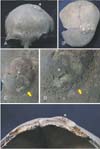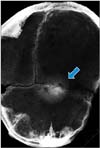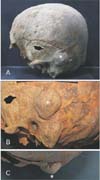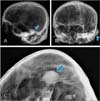Abstract
To date, there are still very few reports on benign-tumor cases based on East Asian skeletal series, even though other regions and continents have been well represented. In our study on the Joseon Human Skeletal Series, we identified benign bone tumors in two skeletons (cases Nos. 75 and 96). Our radiological analyses showed both cases to be homogeneous sclerotic bone masses aligned with the cranial vault suture. In a subsequent series of differential diagnoses, we determined both cases to be osteoma, the most common bone-tumor type reported for archaeological samples. Our study is the osteoarchaeological basis for this, the first-ever report on benign bone neoplasm in a pre-modern East Asian population.
Investigations of the traces of ancient diseases remnant in archaeologically obtained skeletons can build a comprehensive understanding of the overall health statuses of societies long past. Among the most frequently identified ancient diseases in archaeologically obtained skeletal series are those manifesting as bone tumors [1]. In fact, there are a number of pioneering studies on bone tumors obtained from archaeological skeletal series. Benign bone neoplasms for instance, including osteoma, osteoid osteoma, osteoblastoma, osteochondroma, meningioma, and exostoses have been reported [12345]. The malignant bone tumors, discovered in skeletal series worldwide, also have been reported [678].
However, there have been noticeably few studies on bone neoplasm in collected skeletal series from East Asian countries, while various types of bone tumors were indeed found in East Asia. This constitutes a somewhat glaring gap in the understanding of the occurrence of bone-forming tumors in pre-modern populations.
Over the past several years, we have built at Seoul National University a Joseon Human Skeletal Series (JHSS) consisting of bones collected from 16th-18th century South Korean tombs. The purpose of the present study was to examine JHSS bones and to perform differential disease diagnoses based on the characteristic features of the tumors discovered therein. We herein present the first-ever East Asian skeletal-series-based report on the presence of diseases among a pre-modern population.
We examined the skeletons of JHSS maintained in Seoul National University College of Medicine, South Korea. Most of skeletons were collected from the Hoegwakmyo tombs of Joseon Dynasty (1392-1910 CE). Briefly, archaeologists in Korea found that the distribution of Joseon Hoegwakmyo tombs covered a significant portion of the Korean peninsula in 16th-18th century [9].
In this study, we focused on the osseous growths of bones identified on the two different skeletal individuals in JHSS. The bones of cases No. 75 (EP 4-13) and No. 96 (EP 1-379-1) were found from the Joseon tombs located in Eunpyeong-gu, Seoul, South Korea. The archaeological excavations were performed by Hangang Institute of Cultural Heritage (Seoul, Korea).
The skeletal elements of cases Nos. 75 and 96 were assessed macroscopically and radiologically, following the guideline provided by Ortner [1]. Sex was determined by methods recommended by Buikstra and Ubelaker [10]. Age was estimated by auricular-surface degeneration of the hip bone, based on the degree of transverse organization, granularity, apical activity, retroauricular area degeneration, and auricular-surface porosity [11]. The age was accordingly categorized into eight phases: 1-2, young adult (20-35 years old); 3-6, middle-aged (36-50 years old); and 7-8, old adult (over 50 years old).
Cases Nos. 75 and 96 were radiographed at both Seoul National University of Hospital and a private rehabilitation medicine hospital in Seoul. The radiograph parameters applied were 63 kVP, 8 mA, 11.3 milliseconds exposure time and 1.1-1.2 m distance. The gross examination findings were compared with those of correspondent radiographic images of each case.
The skull of this case was partially preserved. Remained skull parts include temporal, maxilla, sphenoid and ethmoid bones. Age as well as sex estimation was complicated in this case because skeletal structures such as pubic symphysis and auricular surface, etc. did not remain.
In macroscopic analysis on the skull, we found circular bone mass located slightly aside from bregma, being laid in line with the left frontoparietal suture (Fig. 1A, B). A number of nutrient foramina were also observed around the mass, indicating the fast-growing bone patterns (Fig. 1C, D). The bone mass could be identified in the outer table of skull. It was elevated above the normal part of the skull by about 6.5 mm (Fig. 1E).
In plain radiograph of the same skull, we identified round homogenous mass with a smooth border. The diameter was 37.6×36.9 mm. On X-ray image, radiolucent areas were identified in the middle of mass (Fig. 2). To confirm the identity of radiolucent areas, we compare the skull surface (both external and internal) with the same area on X-ray image, finding that the radiolucency is not relevant to the nidus, which is made of cartilaginous materials, but caused by unknown reasons or postmortem bone alterations. The skull under examination exhibited no other pathological findings on radiographs.
The skull of this case was mostly preserved but maxilla and mandible. By age and sex estimation, this case was determined to be middle aged (35-50 years) male. Similar to case No. 75, dome-shaped bony mass appear to be in line with squamous suture, slightly above external acoustic meatus (Fig. 3A, B). The ballooned bone mass was elevated above the plane of normal part of the skull by 10.55 mm (Fig. 3C).
On plain radiograph, we found well-circumscribed mass with smooth border and homogeneous mass, corresponding well to the typical characteristics of osteoma. The diameter of bony mass was 37.5×24.1 mm (Fig. 4A-C). The skull under examination exhibited no other pathological findings.
Osteoma is the most commonly observed bone tumor in archaeologically obtained bones [1]. The incidence rate of cranial osteoma, on some estimation, has been as high as 50% of archaeological samples [12]. According to the previous studies, osteoma forms a solid bony mass in the periosteum and outer table of the skull [1]. In most osteoma, lesions are singular; multiple lesions are relatively rare [1]. Larger osteoma can be 4 cm in diameter and almost 4 mm above the plane of the normal bone at the center of the tumor [14]. We therefore considered osteoma as the leading bone-tumor candidate in our diagnosis of the current JHSS cases.
In brief, each cranial tumor (Nos. 75 and 96), the singular bone masses, on the outer table of the skull, measured less than 4 cm. As in a previous radiological diagnosis of osteoma [4], homogenous sclerosis of bone mass with smooth- and well-circumscribed borders was identified on radiograph images of the current cases.
We also performed differential diagnoses for the other osteoblastic tumors. First, with respect to osteoid osteoma, its predilection site is mainly the long bones such as the femur and tibia, only very rarely in the skull [14]. Osteoid osteoma has been found in earlier studies to commonly exhibit a small distinctive radiolucent nidus that is surrounded by reactive sclerotic bone, with or without central calcification [14]. In case No. 75, although similarly radiolucent areas in the skull were identified, we could rule out osteoid osteoma, as the radiolucent lesion was confirmed to be a pit formed from arachnoid granulations.
Our next differential diagnosis considered osteoblastoma, the so-called giant osteoid osteoma. Osteoblastoma is generally similar to osteoid osteoma, though of course larger [13]. Its predilection sites, however, are mainly the vertebrae and long bones of the hands and feet [14]. On plain radiography moreover, osteoblastoma typically manifests a relatively weak and heterogeneous density [4]. Based on these findings, osteoblastoma could not be considered as diagnosis for our cases either.
Our final differential diagnosis endeavored to rule out osteochondroma, which accounts for 40%-45% of all benign bone neoplasms [15]. Its predilection site is mainly the metaphyseal surface of long bones such as the distal femur or proximal tibia, and only rarely the skull [115]. On plain radiography, osteochondroma is not homogenous but shows a trabecular pattern, due to the fact that it is composed mainly of trabecular bones contiguous with the medullary cavity [415]. As none of these patterns was seen in either of the current cases, we could rule out osteochondroma respecting the current diagnosis. Considering all of the differential diagnoses together, we identified our present two cases as osteoma.
Taken together, the present study examined the characteristic features of bone-tumor lesions discovered in a Joseon-period skeletal series, and performed differential diagnoses on them for accurate determination of the diseases they represented. According to our macroscopic and radiographic assessments, the most possible diagnosis of these lesions was osteoma. Doubtless, many questions surrounding ancient bone tumors still remain unanswered. Any fuller understanding of neoplastic bone disease, clearly, will require additional paleopathological studies. In this regard, the present paleopathological and osteoarchaeological report on benign bone neoplasm in a pre-modern population will be of considerable interest to concerned researches, especially as it represents the first-ever bone-tumor study based on an East Asian skeletal series.
Figures and Tables
 | Fig. 1Osteoma of case No. 75. (A) Frontal view of calvaria. (B) Superior view of calvaria. (A, B) Circular osteogenic mass (asterisks) located slightly aside from bregma, being in line with the left frontoparietal suture. (C) Well-circumscribed osteogenic mass is observed. (D) The magnified image of panel (C) showing porotic vascularized rim of a lesion (indicated by arrow). (E) Cross-sectional view of osteogenic mass showing external bulging of outer table of diploe with spongy bone. Note bone mass (asterisk) is identified in the outer table of skull. |
 | Fig. 2Osteoma of case No. 75 on plain radiograph showing the extent of a lesion. Round homogenous mass with a smooth border (indicated by arrow) could be seen at the center of the image. Radiolucent areas were confirmed as arachnoid granulations. |
 | Fig. 3Osteoma of case No. 96 in the left temporal bone. (A, B) Lateral view showing circular osteogenic mass (asterisks) lying in line with squamous suture. The hole shown in the squamous part of temporal bone is postmortem taphonomic change. Panel (C) is seen from above. Note that the margin of circular outgrowth mass above the external acoustic meatus is separated from the surrounding cortical bone. |
Acknowledgements
This research was supported by Basic Science Research Program through the National Research Foundation of Korea (NRF) funded by the Ministry of Education (2013R1A1A2009688).
References
1. Ortner DJ. Tumors and tumor-like lesions of bone. In : Ortner DJ, editor. Identification of Pathological Conditions in Human Skeletal Remains. 2nd ed. San Diego: Academic Press;2003. p. 503–544.
2. Rogers L. Meningiomas in Pharaoh's people: hyperostosis in ancient Egyptian skulls. Br J Surg. 1949; 36:423.
3. Gladykowska-Rzeczycka J, Urbanowicz M. Multiple exostoses in a skeleton from a prehistoric cemetary of the former population of Pruszcz Gdanski. Folia Morphol (Warsz). 1970; 29:317–329.
4. Greenspan A. Benign bone-forming lesions: osteoma, osteoid osteoma, and osteoblastoma. Clinical, imaging, pathologic, and differential considerations. Skeletal Radiol. 1993; 22:485–500.
5. Capasso LL. Antiquity of cancer. Int J Cancer. 2005; 113:2–13.
6. Ruffer MA, Willmore JG. Studies in palaeopathology. Note on a tumour of the pelvis dating from Roman time (250 A.D.) and found in Egypt. J Pathol Bacteriol. 1913; 18:480–484.
7. Oakley KP, Tobias PV. The Kanam jaw. Nature. 1960; 185:945–947.
8. Sawyer DR, Wood NK, Allison MJ. An ancient "tumour" from pre-Columbian Chile. J Craniomaxillofac Surg. 1990; 18:136–138.
9. Kim MJ, Oh CS, Lee IS, Lee BH, Choi JH, Lim DS, Yi YS, Han WJ, Kim YS, Bok GD, Lee SD, Shin DH. Human mummified brain from a medieval tomb with lime-soil mixture barrier of the Joseon Dynasty, Korea. Int J Osteoarchaeol. 2008; 18:614–623.
10. Buikstra JE, Ubelaker DH. Standards for data collection from human skeletal remains. Arkansas Archaeological Survey Research Series, No. 44. Fayetteville, AR: Arkansas Archaeological Survey;1994.
11. Lovejoy CO, Meindl RS, Pryzbeck TR, Mensforth RP. Chronological metamorphosis of the auricular surface of the ilium: a new method for the determination of adult skeletal age at death. Am J Phys Anthropol. 1985; 68:15–28.
12. Schuller A. A short review of cranial hyperostoses. Acta radiol. 1950; 34:361–373.
13. Dahlin DC, Johnson EW Jr. Giant osteoid osteoma. J Bone Joint Surg Am. 1954; 36:559–572.
14. Jaffe HL. Benign osteoblastoma. Bull Hosp Joint Dis. 1956; 17:141–151.
15. Vyhnánek L, Strouhal E, Nemmečková A. 'Kissing' osteochondroma: a case from Ancient Egypt. Int J Osteoarchaeol. 1999; 9:361–368.




 PDF
PDF ePub
ePub Citation
Citation Print
Print



 XML Download
XML Download